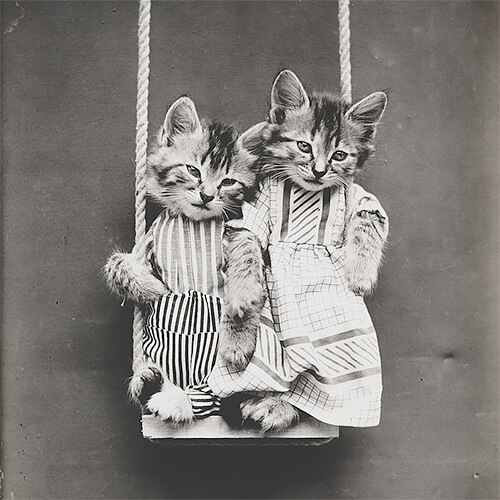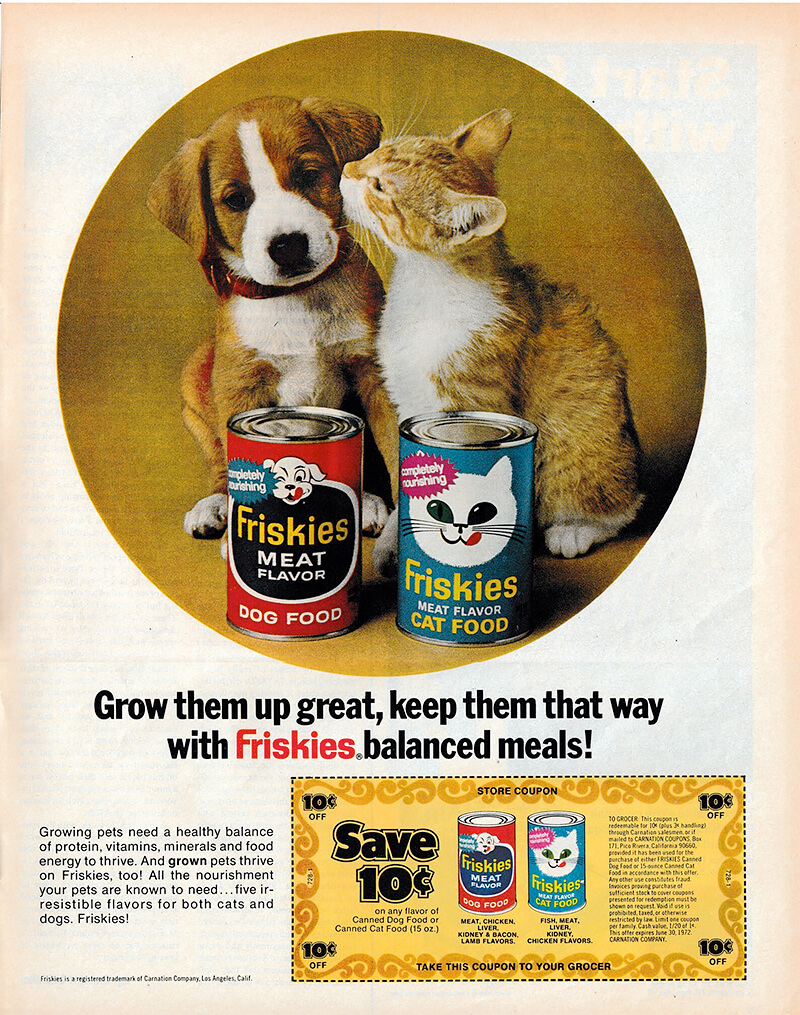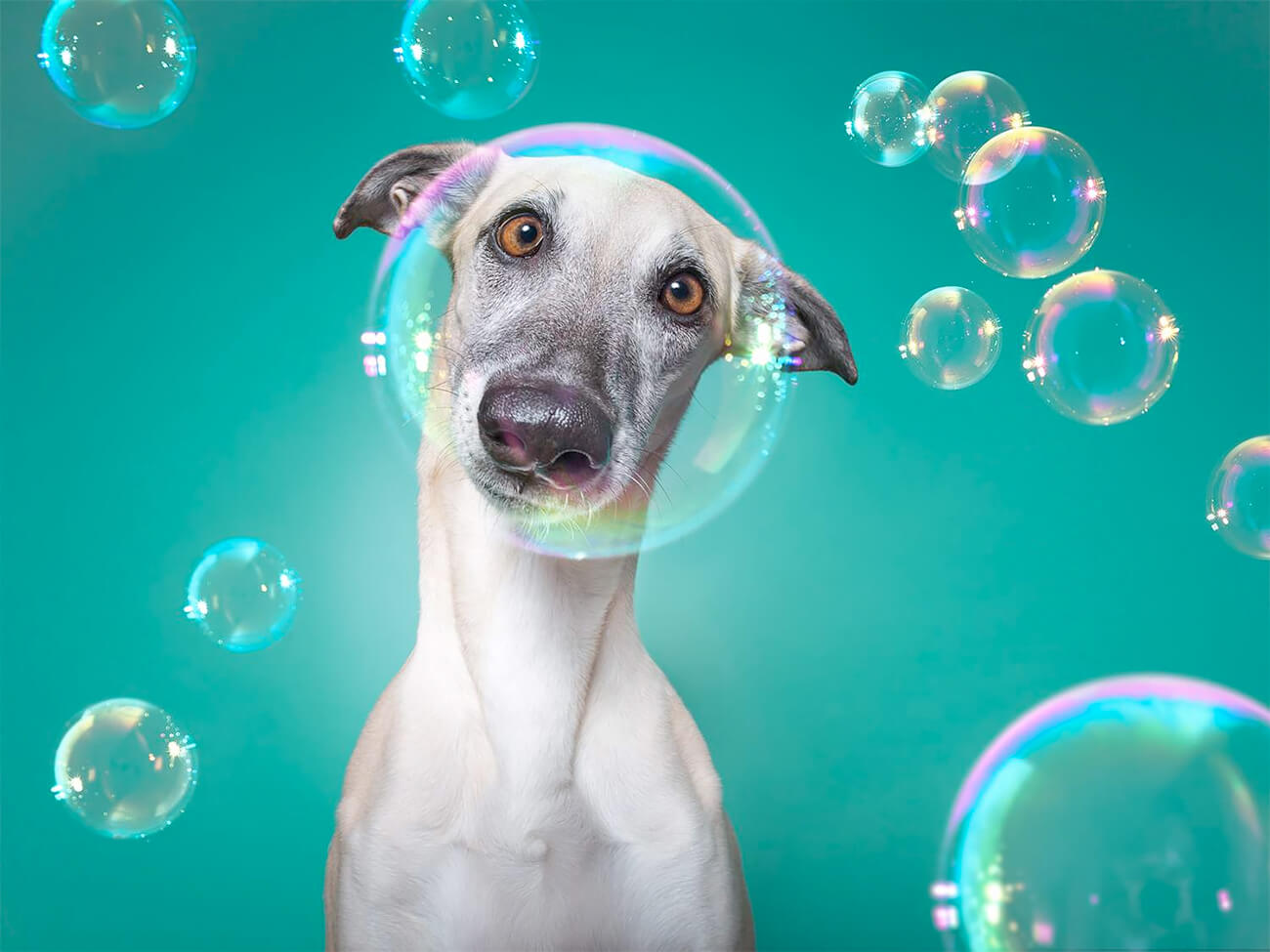Pet photography has been around for nearly as long as photography itself. It's a genre of photography that celebrates the unique relationship between humans and their animal companions. Throughout its history, pet photography has evolved and changed, reflecting both the changing attitudes of society and the development of new technologies and techniques. From early daguerreotypes to contemporary digital images, pet photography has captured the hearts of millions of pet lovers around the world.
The Beginnings of Pet Photography
Early Days of Pet Photography
The history of pet photography dates back to the early days of photography, but it was not a common practice. The first photographs of animals were taken by pioneering photographers such as William Henry Fox Talbot and Louis Daguerre, who used the new technology to document wildlife and domesticated animals. However, these early photographs were primarily intended for scientific or documentary purposes, and not as artistic portraits of pets.
The first known photograph of a pet is difficult to determine with precision. Photographers might have taken pictures of their cats or dogs without us knowing or finding the print that could have been destroyed. But what we know is that the earliest photo taken of a living animal is most likely an image of a cow taken in 1842 by French photographer Joseph-Philibert Girault de Prangey.
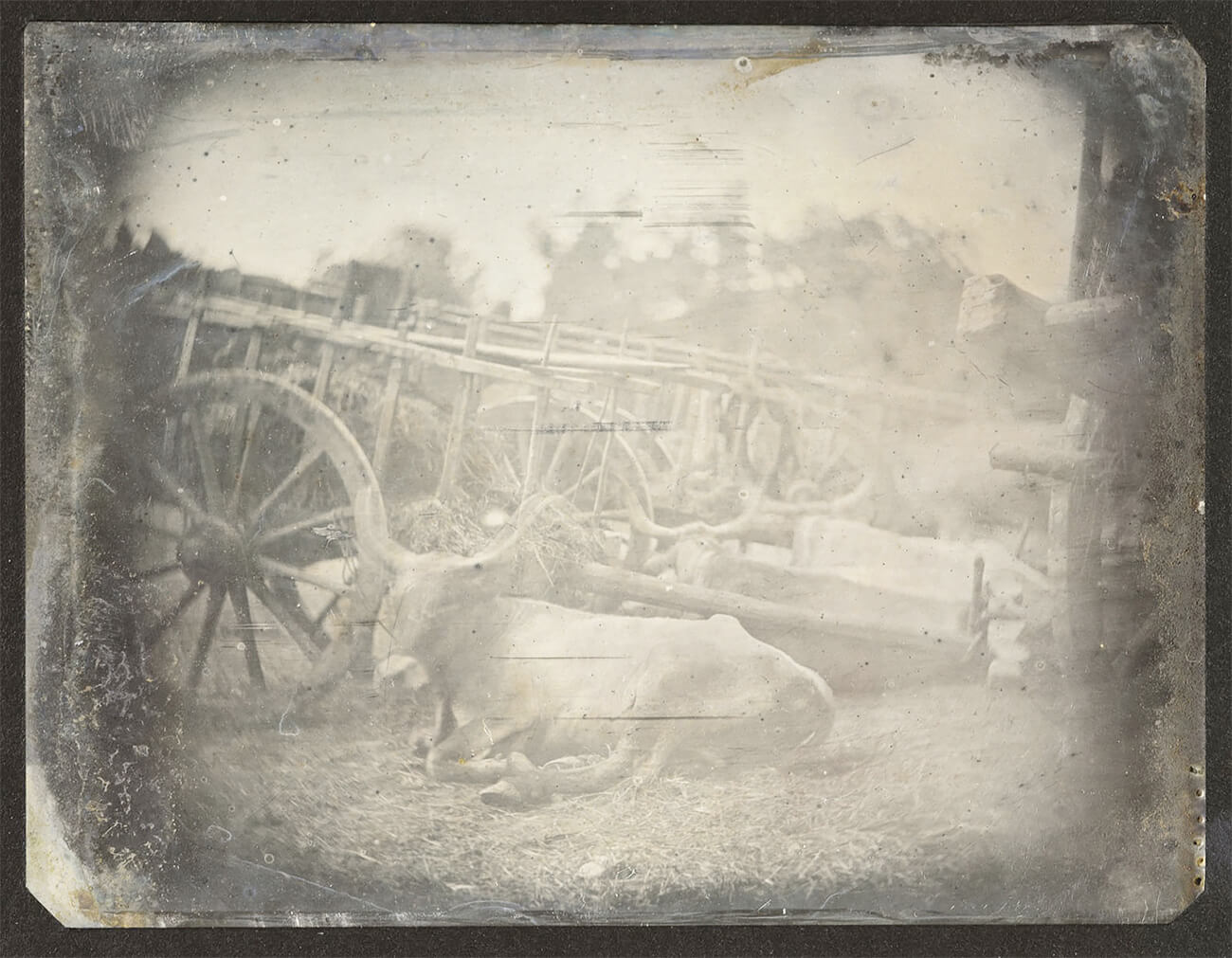
This daguerreotype is believed to have been taken while Girault de Prangey was visiting Rome between April and July in 1842 making it the earliest known photograph of a living animal./Public Domain
Harvard University suggests that the earliest known photo of a cat is a daguerreotype dating from 1840 to 1860. It's conceivable that there are older cat photos, but those photos most likely include their human companions.
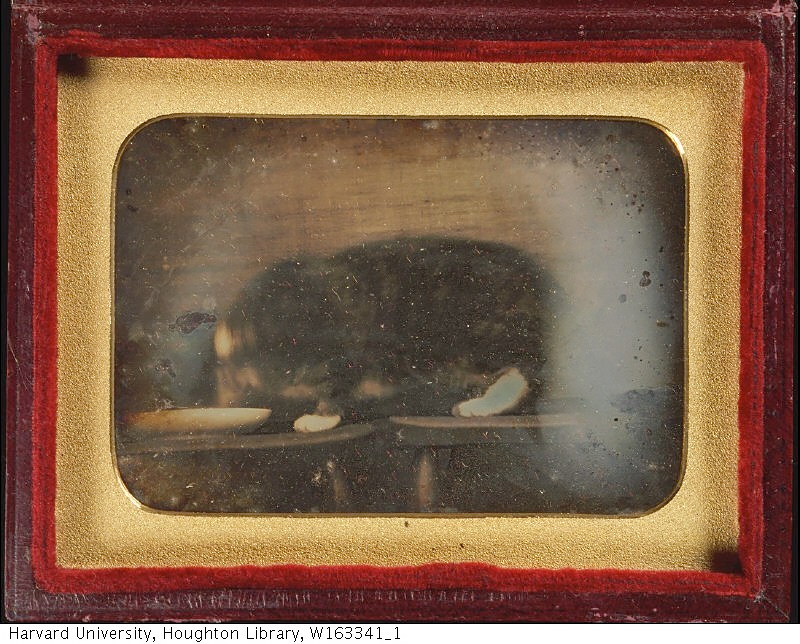
This daguerreotype (catuerreotype?) dates from around 1840 to 1860, Unknown photographer/Harvard University, Houghton Library/Public Domain
The first photograph of a dog could be the bellow portrait of a pet, humorously presented as if in his doghouse (paper overmat), taken by Louis-Auguste Bisson (French 1814-1876) for his childhood neighbor and surrogate sister Rosa Bonheur supposedly taken between 1841 and 1849.
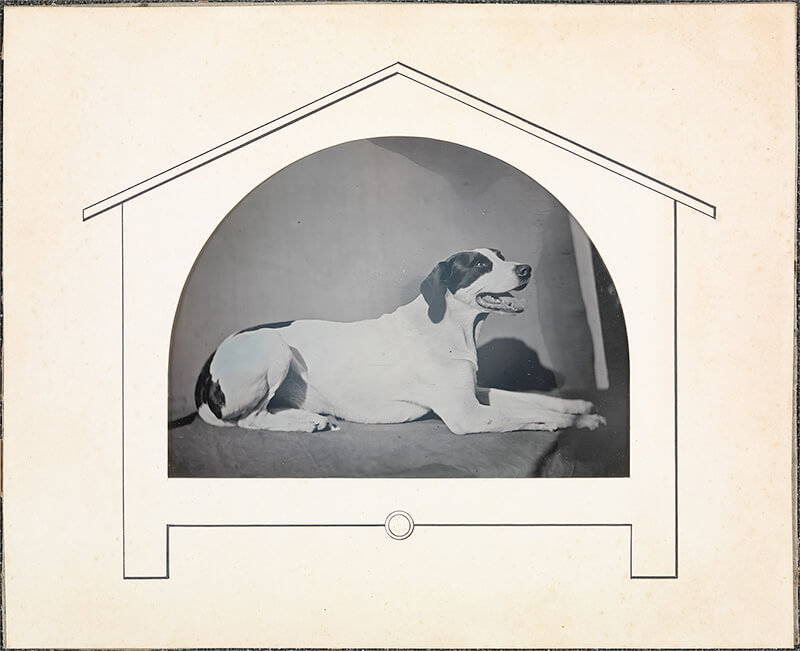
Louis-Auguste Bisson 1841-1849, Gilman Collection, Purchase, Jennifer and Joseph Duke Gift, 2005/Public Domain
Others think that a daguerreotype titled 'Poodle With Bow on Table', taken by an unknown photographer in the 1850s could be the first photograph of a dog . Nothing else is known about the photograph nor the dog besides the fact that it appeared well-behaved to sit quietly for a daguerreotype.
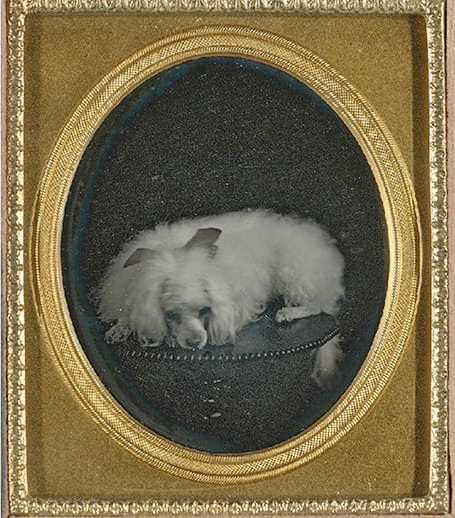
Poodle with Bow on Table, Anonymous American Photographer, 1850s, sold at Sotheby's in 2009
Over the next few decades, as photography became more accessible to the general public, pet photography became more common. As early as the 1860s, photographers were advertising their services as animal photographers, and pet portraits became a popular gift for wealthy pet owners. However, the quality of these early pet portraits was often poor, due to the limitations of the technology and the lack of experience of many photographers.
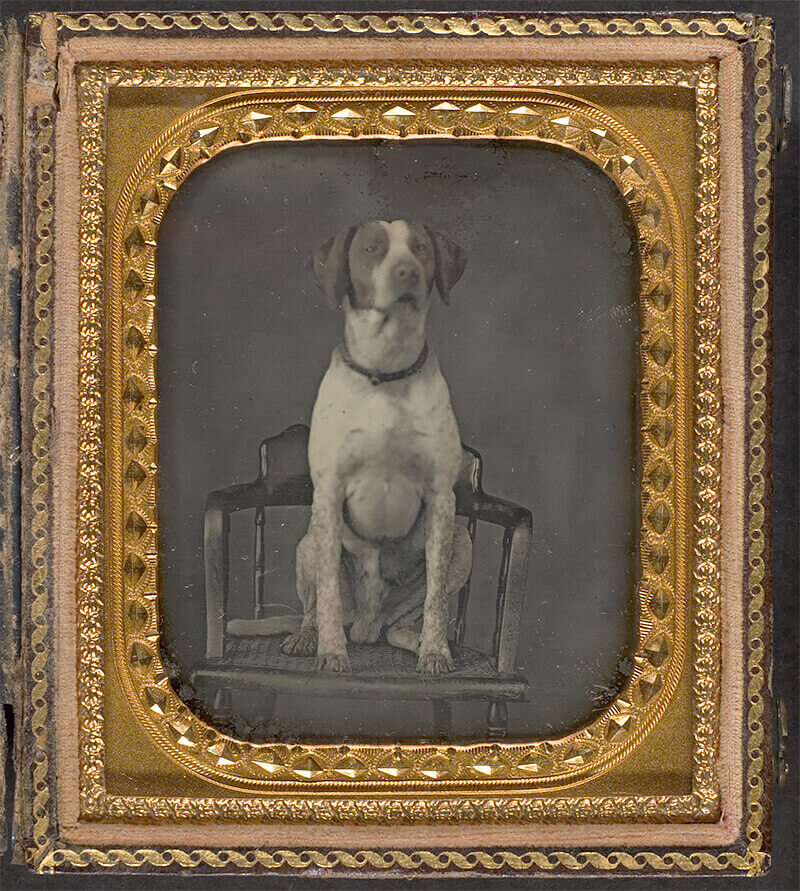
Dog Posing for Portrait in Photographer's Studio Chair, Circa 1855 - photograph by Rufus Anson (MET, 2004.219)
By the late 1860s, Stereographs were a particularly popular format for early animal photos. A stereograph is two nearly identical prints made with a double-lens camera, which are pasted side by side on a card. When viewed through a stereoscope, the two prints combine to create the illusion of 3D. The first stereoscopes (1832), were costly, large devices with a limited selection of images. However, the world of stereoviews drastically expanded after Oliver Wendell Holmes, Sr., created the handheld viewer in 1861.
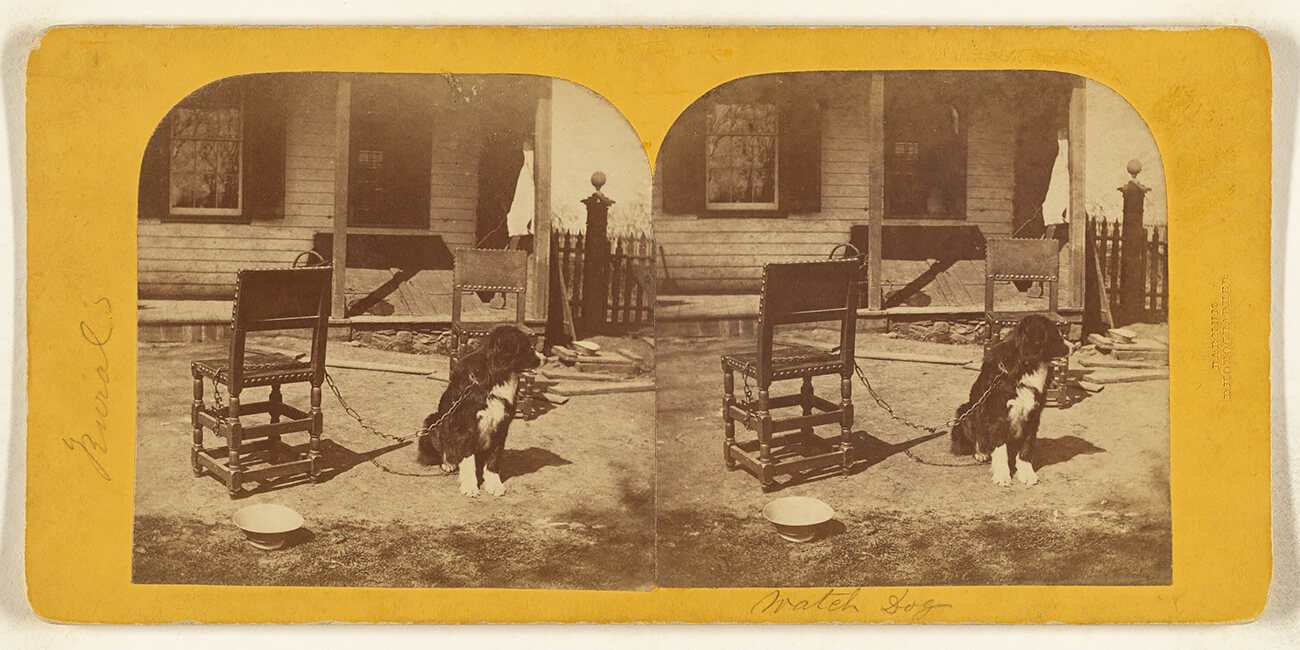
Watch Dog, circa 1860, Deloss Barnum, J. Paul Getty Museum
In the Victorian era, pets became a symbol of social status and prosperity. Wealthy Victorians often kept pets as a way to showcase their wealth and refinement. As a result, pet photography became increasingly popular, with photographers specializing in portraits of cats, dogs, and other animals.
One of the pioneers of pet photography was Harry Pointer, an English photographer who became famous in the 1870s for his humorous photographs of cats. Pointer's photographs, which often featured cats in funny poses or costumes, were popular with the public and were widely reproduced in newspapers and magazines. Pointer's success inspired other photographers to experiment with pet photography, and by the end of the 19th century, pet portraits were a common sight in photographic studios.
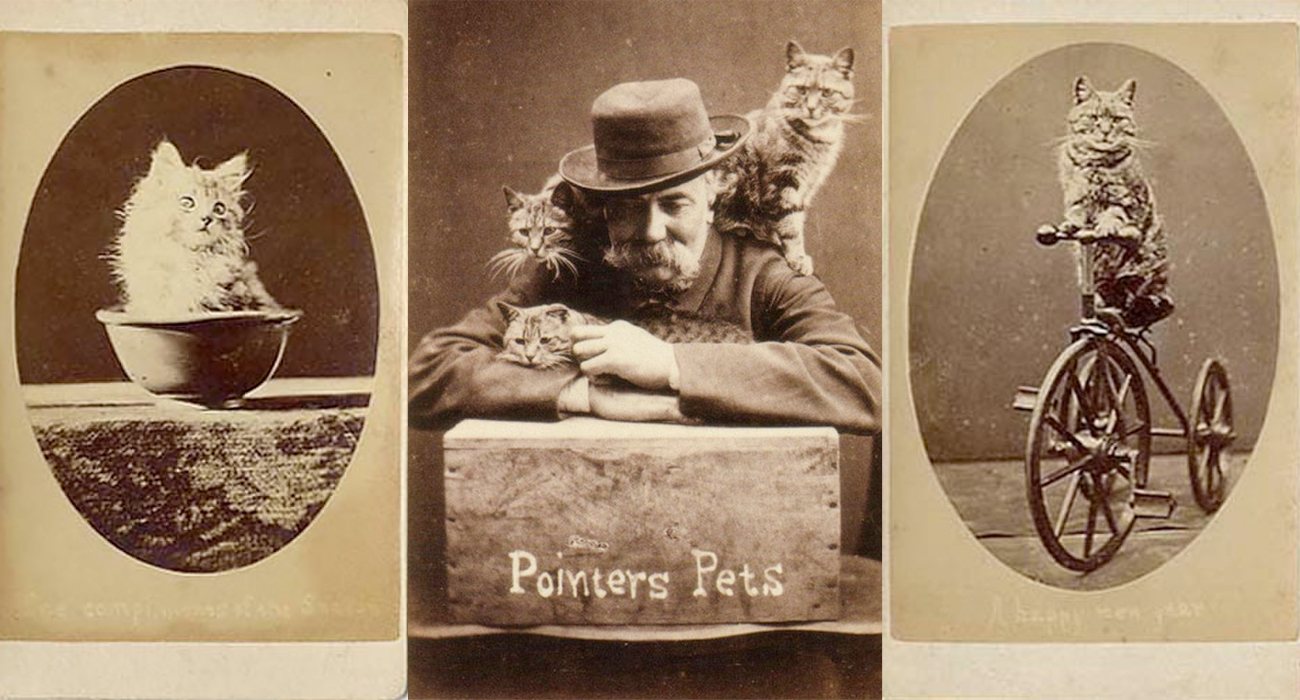
During the 1870s, the Brighton photographer Harry Pointer (1822-1889) became well known for a series of carte-de-visite photographs which featured his pet cats. Pointer began by taking conventional photographs of cats resting, drinking milk or sleeping in a basket, but from around 1870 he specialised in photographing cats in a variety of poses, placing his cats in settings that would create a humorous or appealing picture. Pointer often arranged his cats in unusual poses that mimicked human activities - a cat riding a tricycle, cats roller-skating and even a cat taking a photograph with a camera. Harry Pointer soon realised that even a relatively straight-forward cat photograph could be turned into an amusing or appealing image by adding a written caption. Pointer increased the commercial potential of his cat pictures by adding a written greeting such as A Happy New Year or Very many happy returns of the day. Purchasers sent the small cartes-de-visite as tiny greetings cards, thereby publicizing Pointer's distinctive cat photographs. By 1872, Harry Pointer had created over one hundred different captioned images of cats. Harry Pointer's series of cat photographs were collectively known as The Brighton Cats. The Photographic News reported that, by 1884, Pointer had published about two hundred pictures in The Brighton Cats series.
Source: Sussex PhotoHistory
Another famous example of pet photography from the late 19th century is the series of photographs taken by Harry Whittier Frees (American 1879–1953). Frees was known for his photographs of animals dressed in human clothing and posed in human-like situations. His photographs were popular at the time and continue to be popular today.
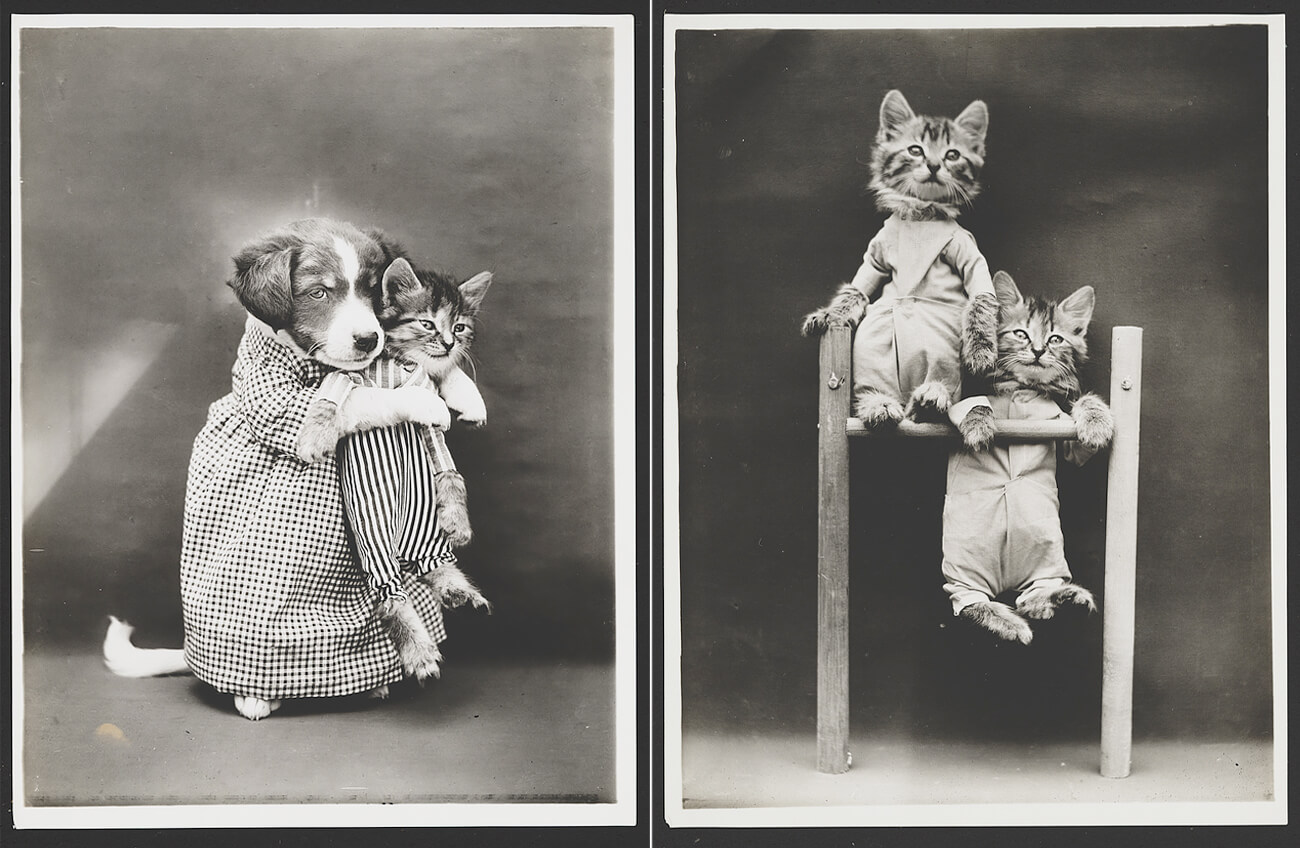
Left image: The nurse 1914, Right image: The acrobats 1914 © Harry Whittier Frees, Library of Congress Prints and Photographs Division Washington, D.C
According to an article, which appeared in the March 1, 1937, issue of Life, Frees began his career purely by accident. Shortly after the opening of the 20th century one of the Frees brought a paper hat to the dinner table for a birthday celebration. The family gaily passed the hat from head to head until, in a final burst of hilarity, someone placed it on the head of the family cat who, up until that time, had taken no part in the fun. Then and there Frees took a photograph of the fashionable feline. The odd picture was so much admired that he took others and sold some to a postcard printer. The printer clamored for more. And so an unconventional career commenced.
Frees’s photographs were uncommon because he used live animals and no tricks were involved. His photographic exposures were taken at one-fifth of a second. Kittens were easily distracted by moving objects and puppies’ attention was diverted by barking dogs. “These unusual photographs of real animals were made possible only by patient, unfailing kindness on the part of the photographer at all times,” Frees said. He borrowed pets from neighbors and rented animals from nearby pet stores.
Source: Pennsylvania Heritage
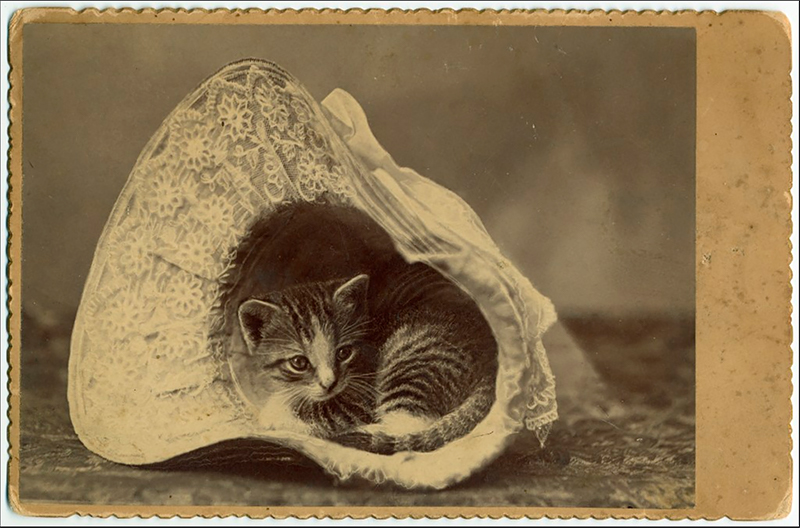
Kitten nestled in a bonnet ca. 1885, George Eastman House Collection
In the 20th century, pet photography continued to evolve and gain popularity. With the development of new technologies and techniques, photographers were able to create more sophisticated and creative pet portraits.
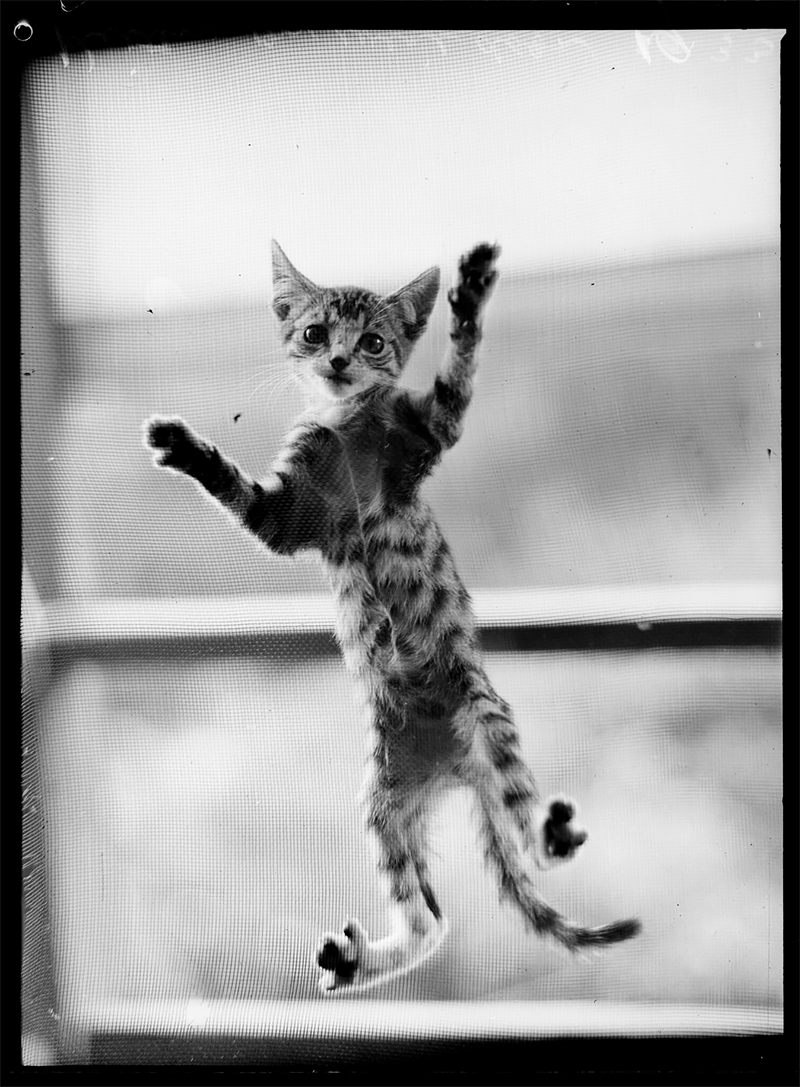
Kitten, on wire mesh door, 19 March 1937, © Norman Herfort/State Library of New South Wales,
Snapshot photography emerged in the late 19th century and became increasingly popular in the early 20th century. This was due in part to the availability of smaller and more portable cameras that were easier to use, such as the Kodak Brownie, which was introduced in 1900. These cameras were affordable, lightweight, and allowed people to take pictures on the go, capturing everyday moments and events.
It was a departure from traditional studio photography, which was often posed, formal, and expensive. Instead, it allowed people to capture informal, candid images of their family and friends (sometimes furry), as well as their surroundings and travels. Snapshot photography also enabled people to document important events, such as weddings and holidays, in a more spontaneous and personal way.
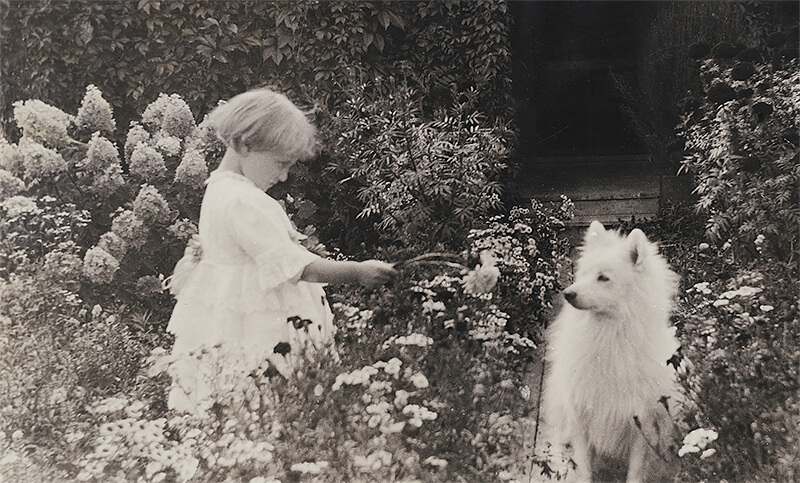
Smell Doggie, Florence Sutcliffe offering flowers to a dog, Montreal, QC, 1920 © Harry Sutcliffe/ McCord
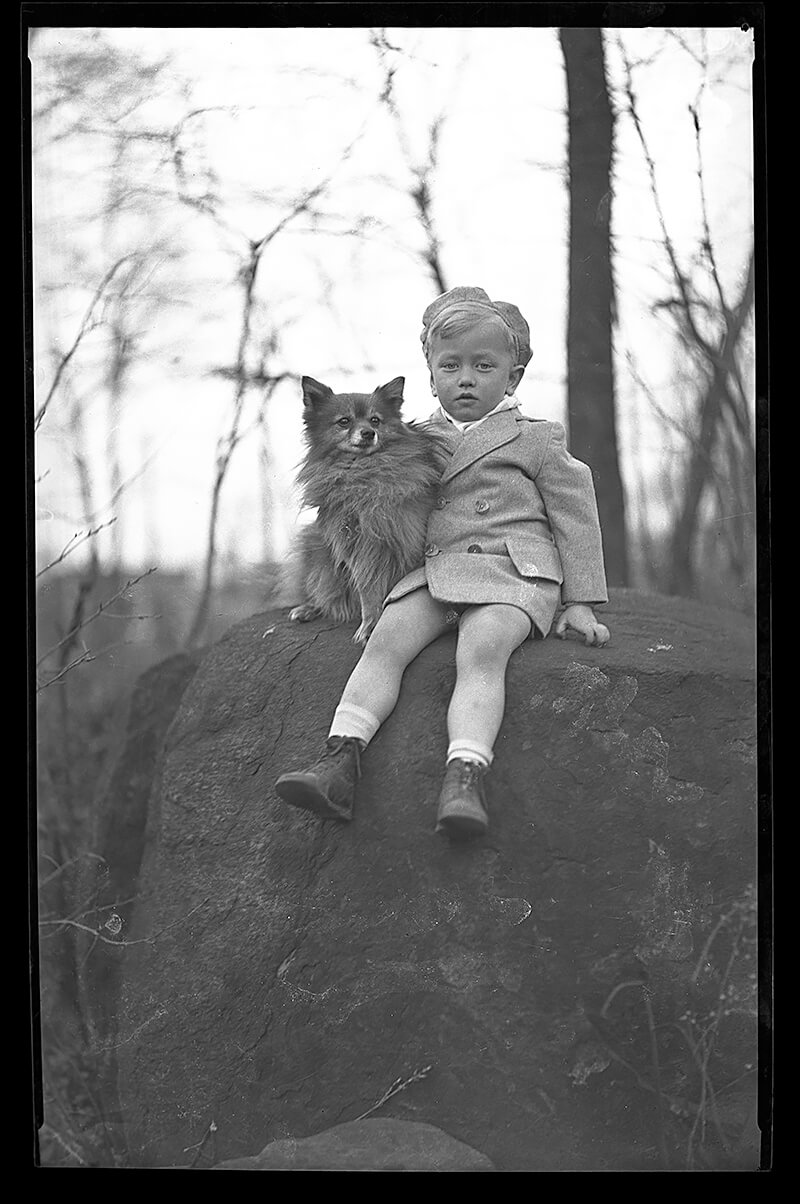
Frank Huntley Sutcliffe outdoors with dog, 1933 © Harry Sutcliffe/ McCord
The early 20th century was a time of great social and technological change, and photography played an important role in documenting these changes. Photographs helped to create a sense of shared experiences and memories, and they were used to advertise products, promote tourism, and document social issues.
Pet photography became increasingly popular during the 1920s and 1930s as more families began to keep pets as companions. The invention of portable cameras and the availability of film also contributed to the rise of pet photography during this time.
As in the 19th century, pet photography was still particularly popular among the wealthy and upper-middle-class families, who could afford to hire professional photographers to take pictures of their pets, or to purchase cameras and films. These photographs were often used to document the lives of the family's pets and to create family albums.
In addition to formal studio portraits, pet photography also included candid shots of pets in everyday situations. Photographs of dogs and cats playing, sleeping, and interacting with their owners were popular subjects.
Magazines and newspapers also featured pet photography during this time, with many publications running contests for the best pet photographs. These contests helped to popularize pet photography even further and encouraged amateur photographers to take pictures of their own pets.
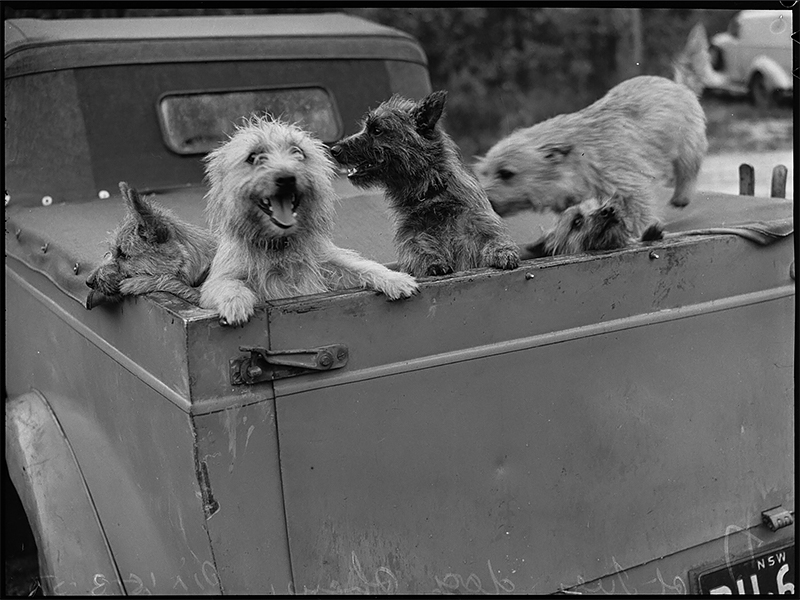
Dog Show, St Ives, Sydney, 13 March, 1950, Pix Magazine, State Library of New South Wales
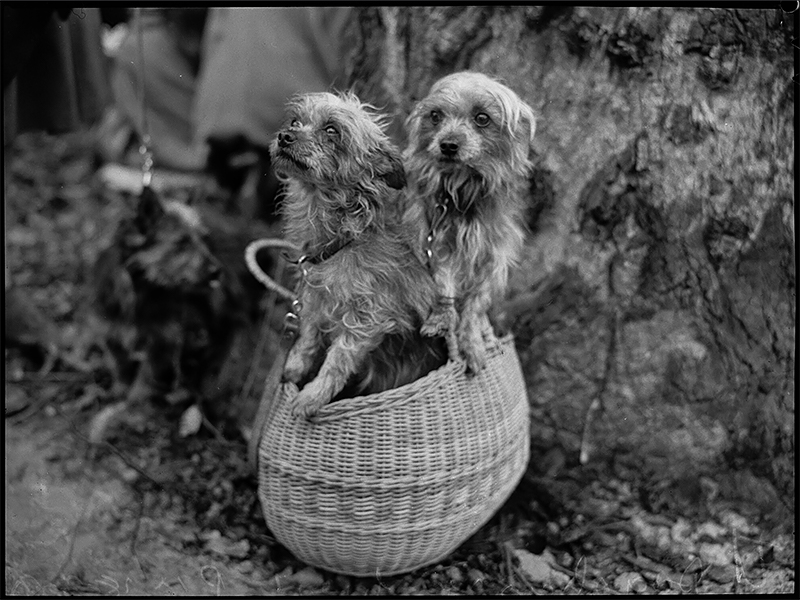
Dog Show, St Ives, Sydney, 13 March, 1950, Pix Magazine, State Library of New South Wales
In the 1930s and 1940s, pet photography became closely associated with Hollywood glamour. Many Hollywood stars of the era, including Clark Gable, Elizabeth Taylor, and Marilyn Monroe, were known for their love of animals. As a result, pet photography became a popular subject for Hollywood photographers.
One of the most famous Hollywood pet photographers of the era was Clarence Sinclair Bull, who photographed many of the era's most famous stars with their pets. Bull's photographs were often highly stylized and posed, capturing the glamour and elegance of Hollywood.
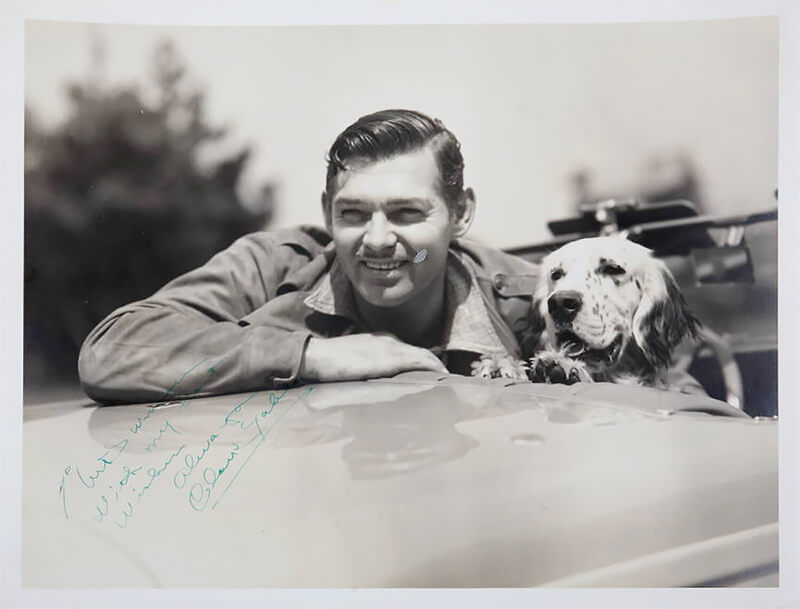
Clark Gable inscribed sepia tone photograph by Clarence Sinclair Bull. Inscription reads in part, ...With my best wishes always Clark Gable.
Another famous Hollywood pet photographer was George Hurrell, who was known for his iconic portraits of movie stars. Hurrell often photographed stars with their pets, capturing the unique bond between humans and animals.
Color Photography
The popularity of pet photography continued to grow throughout the 20th century, as advances in technology made it easier and more affordable for people to take photographs of their pets. In the 1950s and 1960s, the rise of color film and the popularity of Kodak's Instamatic camera made it possible for people to take snapshots of their pets at home. These snapshots, which often featured pets in everyday settings, became a popular way for families to document their lives and their relationships with their pets.
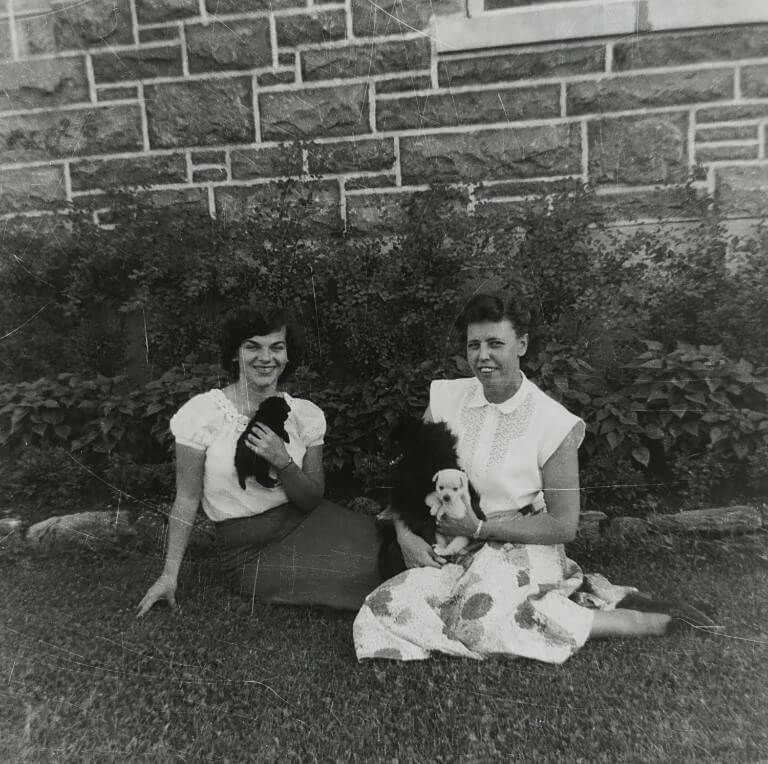
Shirley and Janet Sutcliffe with mother dog and two puppies, Montreal, QC, 1951, Unknown photographer © McCord
Color photography allowed photographers to capture the vibrant hues and textures of fur and feathers, and pet portraits became more lifelike and vivid. Color photography also allowed for new creative possibilities, as photographers could experiment with color combinations and contrast.
Pet photography in the 70s and 80s continued to evolve as more people owned cameras and the popularity of pet ownership grew. During this time, people were still using film cameras, which meant that taking pictures of pets required some level of skill and planning.
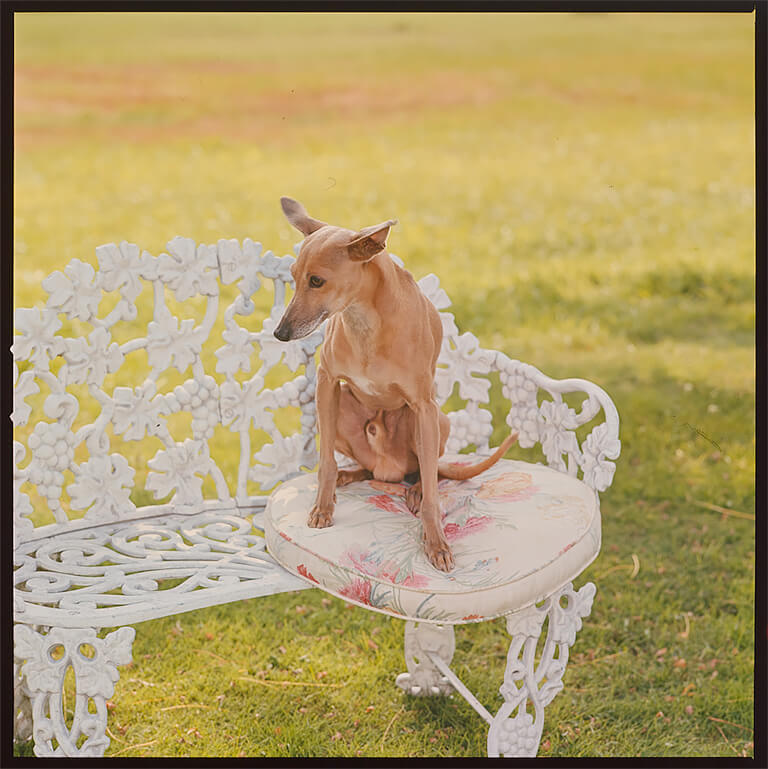
Bambi Color Test 1963 © Toni Frissell / Library of Congress Prints and Photographs Division Washington, D.C
In the 70s, pet photography became more creative, with pet owners posing their pets in humorous or artistic ways. Pets were often photographed in outdoor settings, such as parks or gardens, to capture their playful and active nature. Pet portrait studios also became more popular, with professional photographers specializing in pet photography.
In the 80s, pet photography became more accessible with the introduction of point-and-shoot cameras. These cameras were affordable, portable, and easy to use, making it easier for pet owners to capture candid shots of their pets at home or on the go. As a result, pet photography became even more popular, and many people started to incorporate their pets into their family photo albums.
Commercial Pet Photography
In the mid-20th century, pet photography became a popular commercial enterprise. Photographers began specializing in pet portraits, and pet owners could hire photographers to take professional portraits of their beloved animals. Commercial pet photography studios began popping up in shopping malls and pet stores, offering affordable and convenient pet portraits.
The 80s also saw the rise of pet photography in advertising and commercial photography. Pets were often used in advertisements to sell pet products, but they also appeared in ads for other products, such as cars, food, and clothing. This trend continued into the 90s and beyond, with pets becoming a ubiquitous presence in advertising.
Pet Photography as Art
As pet photography became more popular, it also began to be recognized as a legitimate art form. In the 1970s and 1980s, photographers such as
William Wegman (1943- ) began to explore the creative possibilities of pet photography, creating images that were both visually striking and emotionally powerful. Wegman's photographs of his dogs were characterized by their surreal and playful quality, often featuring his dogs dressed up in costumes or posed in unusual positions. Wegman's work has inspired many pet photographers since, and his Weimaraner portraits remain iconic examples of pet photography.
Acclaimed Magnum photographer
Elliott Erwitt's (1928- ), fascination for dogs dates back to the forties when he was a lonesome teenager wandering the streets of Hollywood with his camera. Years later, while revisiting his archives, he realized the extent to which dogs occupied an important place. These unconventional portraits became his atypical way to address the human condition, the pooches acting as mirrors for mankind.
The photographer developed a surprisingly close relationship with his canine friends, revealing their personalities, marked by independence, loyalty and, at times, silliness… In Erwitt’s universe, dogs do not fear embarrassment. Pure breeds or mongrels, family members or strays, Elliott Erwitt celebrated all dogs as models of the devoted and kindhearted companion. After all, in this dog's life, man becomes an accessory.
''I take a lot of pictures of dogs because I like dogs, because they don't object to being photographed, and because they don't ask for prints.''- Elliott Erwitt.
Contemporary Pet Photography
Today, pet photography continues to evolve and thrive as a genre. With the advent of digital photography and social media, more and more people are taking photographs of their pets and sharing them with the world. Pet photography has become a popular hobby for amateur photographers, and there are countless online resources and communities dedicated to pet photography.
Professional pet photographers continue to specialize in pet portraits, offering customized and creative images of pets that capture their unique personalities and characteristics. Many professional pet photographers have also embraced new technologies, using drones and 360-degree cameras to capture new perspectives and angles of pets.
Pet photography has a long and rich history, from the early days of photography to the present day. Throughout its history, pet photography has evolved and changed, reflecting both the changing attitudes of society and the development of new technologies and techniques. Today, pet photography is a thriving genre, offering a unique and creative way to celebrate the beauty and companionship of pets. Whether as a hobby or a profession, pet photography continues to inspire and captivate audiences around the world.
Photographers to Follow on Instagram
Elliott Erwitt
William Wegman
Kaylee Greer
Seth Casteel
Carli Davidson
Grace Chon
Elke Vogelsang
Theron Humphrey
Robin Schwartz
Sophie Gamand
Walter Chandoha Archive
Sharon Montrose
Photo books
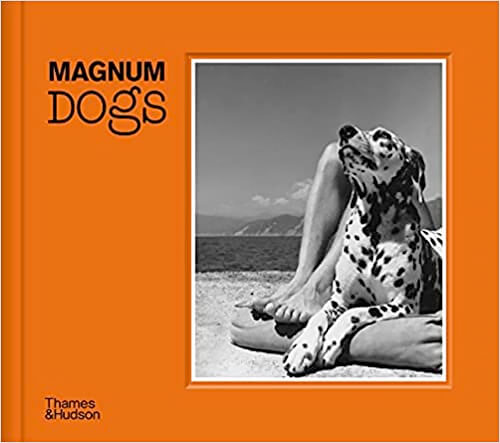
Magnum Dogs, Thames & Hudson 2021
More information about the book
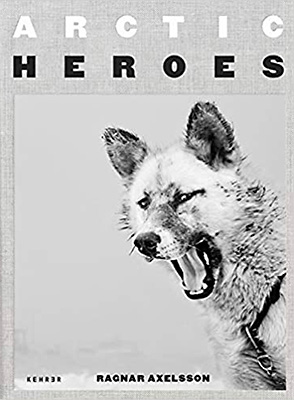
Ragnar Axelsson: Arctic Heroes: A Tribute to the Sled Dogs of Greenland, Kehrer Verlag 2021
More information about the book
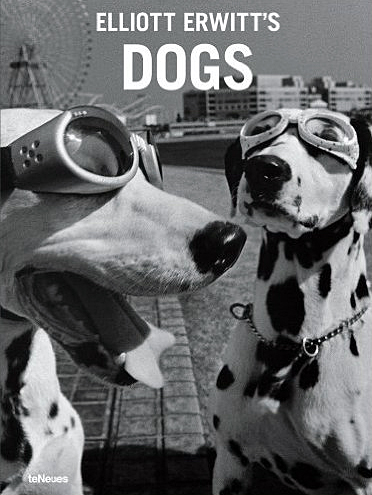
Elliott Erwitt's Dogs, teNeues 2012
More information about the book
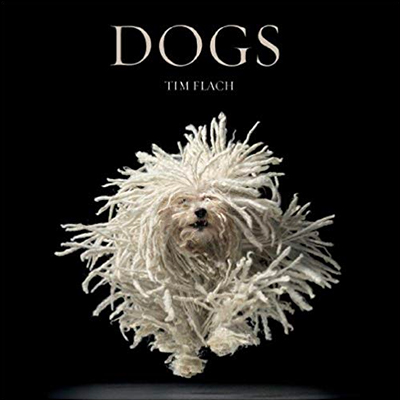
Tim Flach: Dogs, Harry N. Abrams, 2010
More information about the book
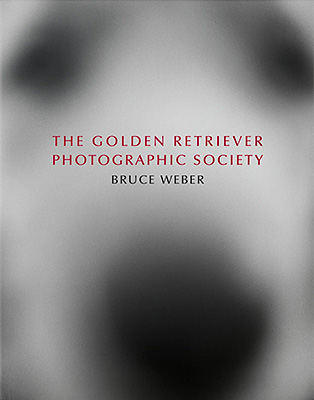
Bruce Weber: The Golden Retriever Photographic Society, Taschen 20214
More information about the book
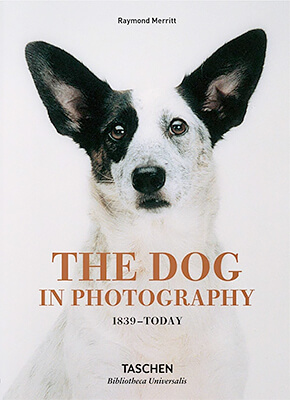
The Dog in Photography 1839-today, Taschen, 2018
More information about the book
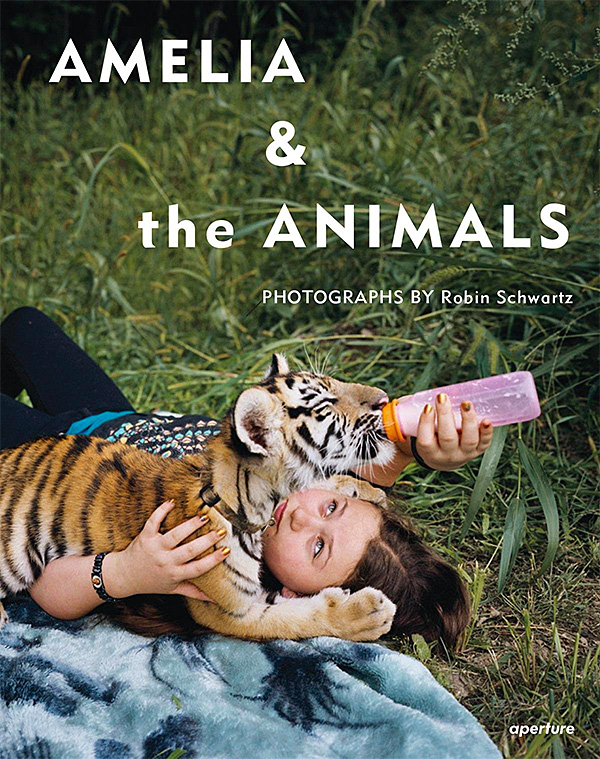
Robin Schwartz: Amelia and the Animals, Aperture 2014
More information about the book